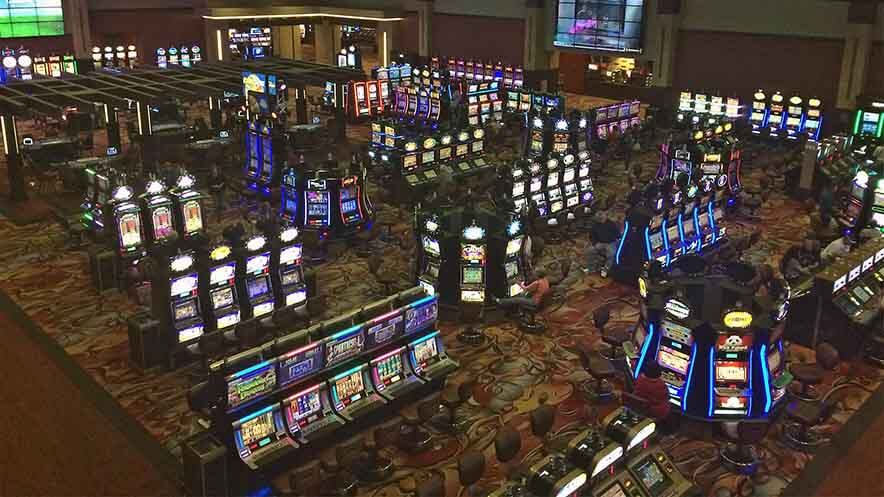A Casino Makes a Sure Bet
This multifaceted approach is key to protecting guests who visit the casino, which houses 1,400 slot machines and more than 20 table games, several restaurants and bars, and a 36-lane bowling center.
The casino, owned and operated by the city of Santa Ana, falls under tribal gaming rules set by the Santa Ana Gaming Commission. That body takes existing rules from the National Indian Gaming Commission and applies them to local casinos. Security measures dictated by the national commission are considered minimum standards and more stringent security provisions are often applied. Every month, Edeal meets with the Santa Ana commission to stay up to date on these policies and procedures. “It’s basically an ongoing working relationship with them,” he says.
Because of casino rules, the 15 members of the surveillance team face unusual challenges. “There are a lot of controls when it comes to even just how the dealer pays out a bet. Is it sized in properly? Is the index finger dragged across the top of the bet properly? There are little things like that you get into in the subtlety of casino surveillance that you don’t see in other industries,” Edeal notes.
The control room at the casino is critical to surveillance operations. It was renovated and moved to the other side of the facility in August 2015. Edeal says that presented a good opportunity to upgrade the hardware and software used for surveillance, much of it from Hikvision products.
Edeal first came across Hikvision in 2007 when the casino moved from a VCR-based system to a digital recording system. The DVRs he chose were using Hikvision encoders to convert the camera signals from analog to digital. In 2011, he chose Hikvision for all digital recording at the casino, installing 40 DVRs and eight storage servers from the vendor.
During the recent upgrade, Santa Ana Star Casino replaced the 40 DVRs with 24 hybrid DVRs equipped with several Hikvision products, including iVMS-5200 software, new encoders, and 10 storage servers. The encoders allow the casino to integrate existing analog cameras into the IP video management system. The additional storage capacity provided in the upgraded equipment is necessary, Edeal explains, because video of any incident from the casino that could potentially be needed later is archived indefinitely. All other video is kept for 21 days before being automatically deleted.
The archived video has saved the casino from lawsuits on several occasions and, Edeal says, the surveillance team conducts numerous risk assessment reviews of the video footage. For example, in the bowling center, bowling lanes are oiled past the foul line. If someone crosses that line, they are likely to trip and fall. “There’s probably at least one of those a week that comes through where we have to determine, did they cross the foul line, is there any potential exposure to us from a liability standpoint?”
During another incident, a male guest tripped and fell on the casino floor. The casino archived the video, but didn’t hear back from the patron. Many months later, a lawyer called saying the man wanted to sue for pain and suffering.
“Because we have an archived video, we went back, looked at the situation, and the guest literally tripped over his own feet, and the video clearly showed that and the lawsuit just went away,” Edeal says.
A login allows operators to go into the system and pull video, as well as view and control the casino’s approximately 650 cameras. Edeal says he has a high level of control when it comes to setting permissions for operators to have access to certain cameras. “That’s one of the things I like about the [Hikvision] software,” he says.
Most of the cameras are standard definition, Edeal notes, because they are used only for basic surveillance purposes. However, Edeal says the casino is undergoing an upgrade to install more HD cameras. Those locations have been chosen strategically in case an investigation needs a higher-quality image. “I’m usually very targeted about where we’re going to add high-definition cameras as we continue to upgrade specific areas,” he notes.
For example, HD cameras are posted over table games to protect against cheating and to ensure that dealers are following policies and procedures with players. “We look at areas like cash handling and say, ‘Are they following the proper controls for how money is supposed to be counted in certain areas? Are they clearing hands when they’re supposed to? Are they shuffling cards the way they’re supposed to?’ And so we analyze those things on an ongoing basis.”
The Hikvision software has a feature called E-Map that provides officers with situational awareness in the event of an incident. “Staff can bring up a camera for a particular area and investigate a situation,” Edeal notes. Many of these cameras are pan-tilt-zoom (PTZ), which allow a greater level of control over what the camera is looking at.
Edeal conducted training with his staff on the upgraded software. He was able to pull a few cameras in for these sessions even though the control room wasn’t fully operational. “It was a learning curve, but they all took it pretty quickly–being familiar with the Hikvision product already on the control client really helped,” he notes.
Edeal says that because surveillance is viewed as mostly reactive, he tries to keep his staff engaged. He teaches them to take a proactive approach to their jobs–especially with all the controls they have to enforce in the gaming world. “I’m big on metrics, so I’m constantly evaluating how many camera patrols the staff does,” he notes. “What gets measured gets done so…I think the staff responds to that.”
For more information: Hikvision, www.hikvision.com; [email protected]; 909/895-0400
